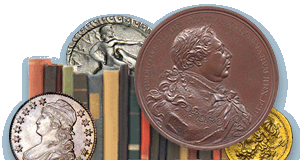
PREV ARTICLE
NEXT ARTICLE
FULL ISSUE
PREV FULL ISSUE
CONFUSING IMPERIAL NAMES ON ROMAN COINSMike Markowitz wrote an article in CoinWeek on Confusing Imperial Names on Roman Coins. Here's an excerpt - see the complete article online. -Garrett
In Latin, "maximus" means "the greatest," as in the name of Rome's famous chariot racing stadium, the Circus Maximus. The high priest of the Roman state religion was the Pontifex Maximus, a title later adopted by the Popes. In the film Gladiator (2000), the hero, played by Russell Crowe, is named "Maximus Decius Meridius." Maximus was mostly an honorific title, not a common Roman personal name, but several emperors had names containing the root *max. On coin inscriptions, which are often heavily abbreviated and may be partly illegible, this can be a source of endless confusion, especially for beginners. A survey of the coins of these similarly-named rulers gives us a glimpse into the often chaotic history of the Roman Empire in the third, fourth, and fifth centuries. Maximinus Thrax Gaius Julius Verus Maximinus was born about 173 CE to a peasant family in the Balkan region of Thrace. He is known to history as Maximinus Thrax: "the Thracian." He was tall and strong – according to one ancient source, 2.4 meters tall (7 feet 10 inches!) Emperor Septimius Severus made him an imperial bodyguard. Emperor Severus Alexander promoted him to army commander. Following the murder of Alexander in 235, Maximinus was proclaimed emperor by the army. His coinage is extensive, with one reference listing seven types in gold, 21 in silver, and 37 in bronze. A magnificent gold aureus dated to Summer 236 bears his bearded, heavy-jawed profile. The reverse bears a standing figure of Providentia, the personification of forethought, "in the sense of a prescient power capable of creating or altering future events." The denarii of Maximinus (which are only about 50% silver) are common and affordable, even in high grades. Maximinus campaigned successfully against the Germans, Sarmatians, Dacians, and North African tribes, but his high taxes alienated the Roman senatorial class, which revolted against him. His troops murdered him, a fate that would befall many of his successors during the following decades. During his reign, he had never set foot in Rome. Maximus Caesar In 236 CE, Maximinus made his son, Gaius Julius Verus Maximus (born between 217 and 220), his designated successor and gave him the title of "Caesar." The coins of Maximus Caesar bear a youthful portrait that strongly resembles his father. He was murdered along with his father by mutinous troops at Aquileia in May 238. Maximianus 
Maximianus. First reign, AD 286-305. AV Aureus (18.5mm, 5.19 g, 6h). Treveri (Trier) mint. Struck March AD 302. Image: CNG/CoinWeek. Born about the year 250 to a family of shopkeepers near the vital garrison town of Sirmium (today Sremska Mitrovica, Serbia), Marcus Aurelius Valerius Maximianus had a successful military career during the reigns of emperors Aurelian (270 – 275) and Probus (276 – 282). He established a lifelong friendship with his colleague Diocletian, who elevated him to the rank of Caesar (co-emperor and designated successor) in 285. While Diocletian identified himself on his coins with the god Jupiter, Maximianus was identified with the hero Hercules, adding the epithet "Herculius" to his name. There are no coins of Maximianus as Caesar, but by 286, he is identified as "Augustus." He ruled in the West with his capital in Milan, while Diocletian ruled the East from a capital in Nicomedia. A superb gold aureus from the famous Beaurains Hoard of 1922, struck at the mint of Treveri (today Trier, Germany), bears a profile bearded bust of Maximianus, with the thick, muscular neck characteristic of imperial portraits in this era. The reverse depicts Hercules wearing his signature lion-skin headdress. A common antoninianus dated to 294 from Ticinum in northern Italy depicts Victory crowning Hercules, with the inscription VIRTUS AUGG ("Manliness of the Emperors"). By this time, the debased antoninianus was a bronze coin with barely a trace of silver in the alloy.
To read the complete article, see:
Wayne Homren, Editor The Numismatic Bibliomania Society is a non-profit organization promoting numismatic literature. See our web site at coinbooks.org. To submit items for publication in The E-Sylum, write to the Editor at this address: whomren@gmail.com To subscribe go to: Subscribe All Rights Reserved. NBS Home Page Contact the NBS webmaster 
|


